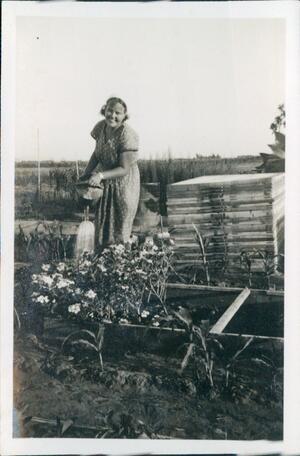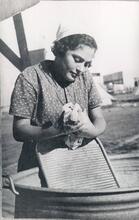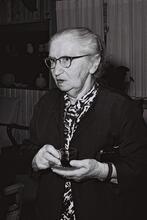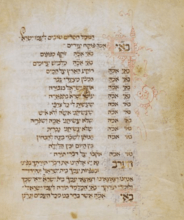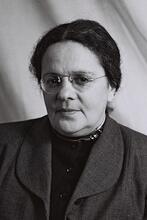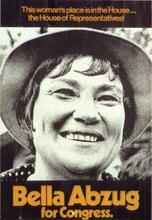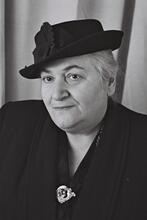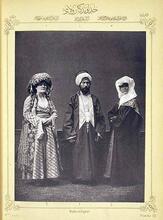Kibbutz Ha-Dati Movement (1929-1948)
A resident of Kibbutz Rodges, one of the first religious kibbutzim in Palestine, waters flowers in the garden, ca. 1930. Source: The Archive of the Religious Kibbutz, from the PikiWiki website.
Like the kibbutz movement in general, the religious kibbutz movement was established as a mixed society in pre-Israel Palestine. The religious kibbutz movement embraced socialism, sought religious innovation, and declared itself a mixed, egalitarian society. This world view should have been fertile ground for gender-related changes in society. However, the religious kibbutz community was also founded upon Jewish tradition, which was patriarchal in nature and based on separation of the sexes. Thus, the changes that the religious kibbutz movement sought to make in women’s status clashed with Jewish law and tradition, as well as with patriarchal views and customs. The innovation of the Kibbutz Ha-Dati movement consisted primarily of raising questions that had been taboo in public discourse, rather than providing answers to them.
Overview
Agricultural settlements based on the collective principles of the A voluntary collective community, mainly agricultural, in which there is no private wealth and which is responsible for all the needs of its members and their families.kibbutz were among the outstanding enterprises of the Zionist movement. While agricultural settlement was an important value in religious Zionism as well, those members of the religious Zionist movement who joined collective settlements constituted a unique group.
The religious kibbutz (Kibbutz Ha-Dati) movement had its beginnings in November 1929 with the Lit. "ascent." A "calling up" to the Torah during its reading in the synagogue.aliyah of a group of pioneers from the Rodges training farm in Germany, who established the Rodges A voluntary collective community, mainly agricultural, in which there is no private wealth and which is responsible for all the needs of its members and their families.Kevuzah in Petah Tikvah and about a year later decided to live a kibbutz lifestyle. At the same time, another group of religious pioneers, graduates of religious pioneer training, developed in eastern Europe and in 1930 founded the Shahal kevuzah in Rehovot. These two groups laid the foundation for the religious kibbutz movement. They were joined by religious pioneers from Europe, young people from the religious Youth Aliyah and members of the Benei Akiva movement in The Land of IsraelErez Israel. The first religious kibbutz, Tirat Zevi, was founded in 1937. In 1948, the religious kibbutz movement comprised some fifteen kevuzot, ten of which were kibbutzim grouped in three blocks (Bet Shean valley, Gush Ezyon, the Negev). Of the approximately 1,500 members, some 600 were women.
The religious pioneers who sought to establish a religious kibbutz movement had two sources to guide them: the secular kibbutz movement, from which they derived the values of collectivism, equality, and individual labor, and Orthodox Judaism, from which they derived religion and tradition. The religious pioneers had to combine these two different, even contradictory, cultures. This problematic encounter between the general kibbutz model and the religious world view generated The legal corpus of Jewish laws and observances as prescribed in the Torah and interpreted by rabbinic authorities, beginning with those of the Mishnah and Talmud.halakhic and social questions that occupied the members from the beginning.
Like the kibbutz movement in general, the religious kibbutz movement was established as a mixed society. Recognition of women’s basic rights, resulting in their full participation in establishing the settlement, was a founding principle of the movement. The religious kibbutz movement embraced socialism, sought religious innovation, and declared itself a mixed, egalitarian society. This world view should have been fertile ground for gender-related changes in society. However, the religious kibbutz community was founded upon tradition, which was patriarchal in nature and based on separation of the sexes. Thus, the changes that the religious kibbutz movement sought to make in women’s status and in the relationships between the sexes clashed with Jewish law and tradition, as well as with patriarchal views and customs.
Women Members and Their Reasons for Joining the Movement
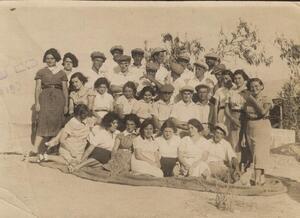
The young women and men of the Shahal Group were from Poland and Romania and were early pioneers of the religious kibbutz movement, founding the first religious kibbutz Tirat Zvi in 1937, among others. Source: The Archives of the Religious Kibbutz, from the PikiWiki website.
Most women members of the religious kibbutz movement were born in Europe and grew up in religious families. They were members of religious pioneer youth movements and underwent training for their move to Erez Israel. The Benei Akiva groups were made up of women born or educated in Erez Israel, while Youth Aliyah founding groups comprised young women who had immigrated to Erez Israel under its auspices. The average age of the members at joining was 23 to 24, but in the Benei Akiva and Youth Aliyah groups it was eighteen to twenty. At the time of their aliyah, the majority of the women members were single.
The motives for their moving to Erez Israel and joining the kibbutz movement were clearly Zionist; above all, they wished to participate in the national renaissance. The young women often aspired to kibbutz life, which seemed to them a realization of the pioneer ideal and an exalted way of life. Some women joined the kibbutz for social reasons; the intimate group was frequently a substitute for the family they had left behind and also the lifestyle best suited to conditions in Erez Israel. In addition, some members thought that the kibbutz lifestyle would change their status, since the group would afford them more options for personal growth.
The outlook of the religious kibbutz movement provided a basis for gender changes, and the women who wanted to join also had new aspirations to self-fulfillment. But the practical implementation of these new ideals was problematic and the gaps between the sexes stood out clearly even at the time when the first members joined the kevuzot.
Far fewer women than men joined the religious kibbutz movement. During the period under discussion, women constituted about a third of the total membership. This proportion, two-thirds men and one-third women, had a significant impact both on women’s status in the kibbutz and on the development of the religious kibbutzim. There were various reasons as to why there were so many more men than women. Firstly, the number of women pioneers who settled in Erez Israel was smaller than that of men; secondly, reasons of economy and defense resulted in men receiving preference upon applying to groups. Some members also cited the lack of training for kibbutz life, especially among women.
Thus the gap between proclamations of gender equality and the factual reality was clearly discernible from the outset. The absence of numerical balance hindered the achievement of equality of status and opportunity between the sexes on the religious kibbutz. Adherence to religious principles that restricted women also contributed to this inequity.
Religion and Tradition
The aspiration of religious kibbutz members to establish new relations between the sexes was especially apparent in their attempt to create a new religious lifestyle. Yet women’s restricted role in traditional Judaism resulted in their exclusion from determining the movement’s religious character. In addition, women’s inadequate Jewish knowledge made it difficult for them to take part in shaping religious life.
Torah Study
The model of the ideal kibbutz member demanded constant engagement in spiritual activity. Yet this was essentially a male model, since traditional Judaism excluded women from religious study. Nevertheless, the kibbutz members’ innovative perception of women is evident in the fact that they not only allowed women to engage in such study, but even encouraged it. There was, however, no unified stance on this. On some kibbutzim, women were prominent participants in religious study, while on others most of the women members did not participate. Yet no kibbutz required the women to study for ideological reasons, as they did with men. Thus, while the religious kibbutz movement’s modern worldview triumphed over traditional opinion, which excluded women from Torah she-bi-khetav: Lit. "the written Torah." The Bible; the Pentateuch; Tanakh (the Pentateuch, Prophets and Hagiographia)Torah study, in effect the new approach was manifested only partially, and the little religious study in which women engaged had no significant effect on their status in the kibbutzim. Yet even if women’s participation in learning was sporadic at best, the new ideological belief on which it was based served as the foundation for the significant innovation which found expression in the second generation of kibbutz members—namely, formal Lit. "teaching," "study," or "learning." A compilation of the commentary and discussions of the amora'im on the Mishnah. When not specified, "Talmud" refers to the Babylonian Talmud.Talmud study for boys and girls alike, which was unknown in the religious world.
Prayer and the Synagogue
One of the most striking innovations attempted by the religious kibbutz movement was joint prayer services for women and men. For years, the dining room served as the synagogue. Men and women sat separately during prayer services, but without a barrier between them. This joint prayer was not deliberately planned, but was rather the result of compelling circumstances. Nevertheless, the religious kibbutz movement did not reject joint prayer out of hand, but attempted to address the issue. This in itself indicated the uniqueness and innovative character of the movement. Joint prayer continued as long as there was no permanent synagogue, but it was clear to the kibbutz members that this was only a temporary practice.
Though the women were ultimately required to preserve the traditional quality of their innovative society, the very existence of discussion of this topic indicates the beginning of a new perception of women’s status in religious society.
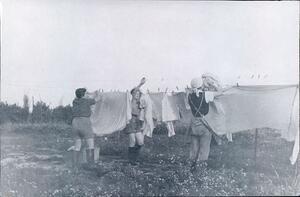
Women members of Youth Aliyah hang laundry at Kibbutz Rodges. Due to the nature of work on the kibbutz and the climate, women often wore shorts on the kibbutzim, like in this photo. It was also symbolic of their rebellion against the traditions of their homes in Europe. Source: The Archive of the Religious Kibbutz, from the PikiWiki website.
Dress
Emulation of the general pioneer mode of dress, combined with agricultural work and climatic conditions, led young women to wear short work trousers, which were also symbolic of pioneering. This style of clothing expressed the young women’s rebellion against the traditional mores of their parental homes. The women members of the religious kibbutz movement changed their traditional style of dress and still maintained an appropriate standard of modesty. Their mode of dress was almost the only way they could express their independence, even in opposition to their own kevuzah. They followed their own inclinations rather than the decisions of others.
Mingling of the Sexes
Mixed choirs, dancing, and even swimming in the swimming pool or pond were common on the religious kibbutz. The members claimed that mixed dancing was an expression of joy at the successful completion of a task or an important event. The general pioneer world, in which there was no separation of the sexes, served as a model for the religious kibbutz, which viewed mixed dancing as a natural outcome of cooperative pioneer life. In this respect, reality dictated practice and the new perceptions proved to be the determining factor.
The religious issues relating to women on which the religious kibbutz movement deliberated indicate the conflict between the new perceptions of gender which it wished to implement and the traditional ones to which it still subscribed. Eventually, when it was necessary to decide on permanent patterns, tradition had great influence. The religious kibbutz movement’s innovation expressed itself primarily in raising questions that had been taboo in public discourse, rather than in the answers it provided.
Women at Work

A group of young men and women on the religious Kibbutz Rodges pose for a group photo. Mingling among the genders was very common on religious kibbutzim. Source: The Archive of the Religious Kibbutz, from the PikiWiki website.
Although the principle of equality was one of the foundations of kibbutz society and the supposed focus of kibbutz life, there was in fact a clear gender-based division of roles, which was all the more pronounced because of the religiosity of the kibbutz members. While their world view was egalitarian, its implementation was incomplete because of the traditional perception that gender differences mandated different work for each sex. The characteristic division of roles on the religious kibbutz placed the men in productive work and the women in service tasks.
The gender-based division of roles was clearly discernible from the outset, during the first stage of arrival at the settlements. Most of the community members were men, with a small number of women. The men, who worked at setting up the farm, needed meals and laundry service, which the women were expected to provide.
Service Professions: “Women’s Work”
Most women members of the religious kibbutz worked in the service areas: kitchen, clothing storage and child care. For the many young religious women who had had no experience in the traditional “female” tasks in their countries of origin, kibbutz life was their first encounter with such work. The service areas were perceived as “female” work despite the fact that cooking and laundry were done under primitive conditions that rendered them physically demanding.

Two women in the Kibbutz Rodges clothing warehouse. Women on religious kibbutzim frequently worked as seamstresses, cooks, caretakers, and in other service positions. Source: The Archive of the Religious Kibbutz, from the PikiWiki website.
The image of the service professions also affected the image of the women members and their status on the kibbutz. Since such work was deemed non-productive, it stigmatized those who performed it as not contributing to the community’s economy. As a result, the women members found it difficult to express opinions during assemblies and meetings, and their role in determining the group’s character suffered accordingly.
Agriculture
Although some women members of religious kibbutzim wished to work in agriculture, the religious kibbutz did not allow all of them to do so. The needs of the kibbutz were the deciding factor, and because of the shortage of young women there was always a compelling reason to direct them to the service professions, even if they had been trained in agricultural work.
Those women who performed agricultural tasks were mostly single, “free” of the responsibilities of child-raising. Marriage meant a change in the woman member’s function, and she usually took service work to be near her children. Occasionally, married women and even mothers who had received agricultural training worked in “female” agricultural branches such as the chicken coop, the dairy, the vegetable garden and the vineyard. As a rule, personal aspirations were secondary; everything was determined according to the kibbutz’s needs. While all the women wished to take an active part in building the community, need was the determining factor.
The women on the religious kibbutz uncomplainingly performed the roles that the group allotted them. They did not protest their relegation to the service professions. Even when they worked in agriculture, they had to leave it the moment they were asked to do so. They internalized the traditional gender view that they must be “helpmates” and felt that in this way they made the best possible contribution to the kibbutz. Innovation, where women were concerned, lay in the expansion of traditional functions, in working outside the home and even in the feeling that they belonged to a unique enterprise and gave it the best they had to offer, thus helping the men to implement the new ideas.
Marriage and Family

Children at a nursery on Kibbutz Rodges. Women often took responsibility for raising the children on religious kibbutzim, despite efforts to create communal and joint childcare. Source: The Archive of the Religious Kibbutz, from the PikiWiki website.
The Kibbutz Family
From its beginning, the religious kibbutz held a conservative world view that affected relationships between the sexes in a religious group. But the realities of kibbutz life created new behavioral patterns even in this area. On religious kibbutzim, society was mixed, but observed the traditional boundaries and behavioral norms characteristic of a religious society.
The religious kibbutz, which did not reject the traditional world, faced a problem when it wished to adopt the general kibbutz family model. It had to take into account the family’s centrality in the religious world, while at the same time remaining faithful to the kibbutz and its unique social structure. The question of family arose even before families were established, as a theoretical problem that had to be prepared for and dealt with.
The religious kibbutz movement discussed the postponement of marriage while stressing the fact that religious society at all times requires marriage. As a result, the members did not decide unanimously in favor of postponing marriage, though they also did not entirely rule out this possibility. Some kibbutzim postponed marriage until they arrived at the site at which they were to settle. The fact that there was no universal decision on the matter but that at the same time an implicit agreement was reached to postpone marriage until the kibbutz was established, set the religious kibbutz movement apart.
A close look at marriage statistics in the religious kibbutz movement shows that despite the fact that this religious population was composed mainly of young people over eighteen years of age, the percentage of married couples in the 1930s and 1940s was relatively small. The postponement of marriage is also evident in the age of women members at the time they married. In 1946, 60 percent of the women members on religious kibbutzim were married, and most were over 25. A quarter of these had married before the age of 25. Of the 40 percent who were single, most were under 25. We can see a tendency toward a relatively higher marriage age than might be expected in a religious society; this was due not only to the prevailing view that building the country came before marriage, but also to living conditions and concentration on establishing the kibbutz. Marriage ceremonies were traditional, but also expressed the new lives of the religious pioneers in Erez Israel, which combined collective pioneering with tradition.
Thus, it was the group that determined the date of the marriage, the budget allocated for it and the length of vacation permitted to the newlyweds. Sometimes several couples were married on the same occasion in order to save money. The ceremonies were modest and the same wedding dress would frequently serve several brides. Some women even forwent the dress in favor of a plain skirt and blouse taken from the workday clothing storeroom, in order to stress their membership in a pioneering society and their rebellion against their bourgeois background. Weddings were often celebrated on Friday afternoon so that the festive Sabbath eve meal would serve as the wedding “banquet.” The ceremony itself was held in a central place; in some kibbutzim, members holding torches served as a guard of honor. A Four-cornered prayer shawl with fringes (zizit) at each corner.tallit served as the wedding canopy (bridal canopyhuppah). At one of the first weddings, in 1934, the rabbi went from member to member of the kibbutz, asking them whether they agreed to the purchase of the ring; the groom had to provide a ring for the ceremony, but since no member of the kibbutz had personal funds, all the members had to consent to part of the community’s resources being used for the purchase.
Cooperative Child Care
Joint child care was an outstanding symbol of kibbutz society. In the field of education and child care, the religious kibbutz movement adopted the ways of the general kibbutzim, accepting their educational system as a natural outcome of kibbutz life. The traditional family structure and pattern of motherhood changed accordingly.
Joint child care and a community dining room were supposed to change gender-based roles, but ended up placing women precisely in these traditional areas of work. Joint child care compelled the women to work in the service and child care fields. Kibbutzim, which wished to abolish individual mothering, institutionalized public mothering. The structure of the family was indeed dismantled, but women’s most important role remained what it had been—the education of children.
The kibbutz’s revolutionary innovation regarding child care caused women enormous pain, placing them in an intolerable situation. On the one hand, tradition restricted them in terms of function and directed them toward home and children, but on the other hand, the innovation did not allow them to benefit from it, since it limited contact between mothers and children. For women, therefore, frustration went hand in hand with the educational innovation.
The Role of Women in Determining the Group’s Character
According to the religious kibbutz movement’s ideals, women were supposed to participate fully in determining the group’s character and in all areas of public activity. But in fact, women members were stuck in the limited confines of the kitchen and the children’s house, and did not appear in public life.
Women in the religious kibbutz movement were excluded from key positions on the kibbutz and from determining its character. The kibbutzim did not include their women members in the secretariat and rarely allowed them to participate in the important committees. Women participated mostly in committees related to their fields of work, such as the kitchen, child care and health. They had influence in those areas, but their absence from important committees adversely affected their ability to define the character of the kibbutz.
Many sources testify to women’s silence during assemblies. They voted and were allowed to express themselves, but few availed themselves of this opportunity. While they expressed their opinions on various matters, they did so only in private. Their voices were not heard in public. In a society that declared itself to be egalitarian, women lacked the self-confidence to speak in public. The disproportionate ratio of men to women was another reason for women’s absence from public life. Motherhood, too, was an obstacle to women’s inclusion in the public sphere, since women devoted themselves more to their homes and children; pregnancy, birth and breastfeeding limited them.
While women members of the religious kibbutz movement were aware of their limited role in public life, they did not fight for their rights on the basis of the kibbutz’s principle of equality. Only rarely did they protest. Women members found that they could depend on others, and their traditional passivity continued. Even the young women preserved the old models in the new setting.
In retrospect, the women later realized that they had not fought over their roles because they felt that home and children took precedence over everything, and they had therefore concentrated on these even on the kibbutz. Although women members had the formal right to hold any office, in practice the kibbutzim relayed a double message and did not really allow equality to be implemented.
The Female Voice

A woman washes laundry on Kibbutz Rodges. Source: The Archive of the Religious Kibbutz, from the PikiWiki website.
The feelings of women members of religious kibbutzim have gone almost completely unrecorded. Their participation in kibbutz writing was minimal, nor is there an account of their private conversations. Yet the fact that they expressed themselves only rarely does not mean they consented to the way affairs were handled on the kibbutz. It seems that the women members’ absence from written reports was the result of the traditional view that associated women with the private sphere. The traditional education of young women also led to their lack of confidence.
The starting point for the women kibbutz members was their participation in building the country. They came to Erez Israel for that purpose, and they were willing to sacrifice much for the sake of that ideal. Kibbutz life seemed to them the realization of the pioneer ideal and most of them joined the religious kibbutz movement to participate in it. They rarely dealt with the question of equality in the group and tended to accept the kibbutz lifestyle as a given. For them, the national goal was the essence of the kibbutz ideal, and while equality and cooperative life were important components of it, they were not the main part. For many women members, the nation was top priority, and equality was not their main aspiration. Therefore, they joined the kibbutz and were willing to live its lifestyle even at personal cost.
The revolution of the religious kibbutz movement’s women members expressed itself in their rebellion against their parents’ wishes for their future, and in their joining the kibbutz, the symbol of Zionism. They saw their contribution to the Zionist revolution in doing what was required of them even if it meant performing traditional tasks. Moreover, this was an entirely new lifestyle, not the tradition of their families.
An analysis of the religious kibbutz movement from the perspective of women and gender shows that, as an ideological movement, it at first sought to bring about changes. It created new religious identities: a young religious man who was also a pioneer, and a young religious woman who attempted to combine work and study. Yet the process of creation of those new gender identities was lengthy and required internalization. The process of creating a new religious woman began in several areas: allowing women to participate in religious study and prayer and creating a significant infrastructure for future generations with regard to religious study for women; change in women’s dress; and eating communal meals in the dining room. Woman’s role in the home and family also differed from the traditional model: motherhood underwent changes because of cooperative child care. In the public sphere, women could participate in public debate and share the responsibility for security.
Yet on the whole one can say that in reality the glorification of masculinity was prominent in all aspects of the group: work, kibbutz management and religious matters. The innovative conceptions were put into practice by men, while the traditional modes of implementation fell mostly to the women, who did not complain of their traditional inferiority. Despite the equal rights granted them by an egalitarian society, they remained the passive component of kibbutz life, and the abilities of the women members were never fully developed. Nevertheless, the traditional saying “All the glory of the king’s daughter is within” was no longer relevant because of the changes in lifestyle and because women now had new options. The religious kibbutz movement, more than any other sector in religious Judaism in the period under discussion, created an opening for women’s involvement in the public sphere, even if this was not fully exploited, either because women were not encouraged to follow through or because the women themselves were not interested in doing so. The religious kibbutz movement created an ideological infrastructure for future gender change in religious society by injecting it with new ideas.
Adar, Gila and Hannah Lewis. Women Members of the Kibbutz (Research Notebooks 19) (Hebrew). Efal: 1998.
Ariav, Hayya. “The Women of Kibbutz Yavneh: The Untold Story, 1942–1948.” M.A. thesis, Touro College, Jerusalem, 1999.
Auerbach, Raphael, editor. ha-Kibuts ba-halakhah: asufat maʼamarim (The Kibbutz in Halakhah: A Collection of Essays). Jerusalem: Sha’alvim Group, 1984.
Bassevitz, Lilia. If Only an Echo (Hebrew). Tel Aviv: Hakibbutz Hameuchad, 1981.
Ben Artzi, Yossi. “Between Workers and Farmers: Women at the Dawn of Settlement, 1882–1914” (Hebrew). In Eshnav le-ḥayehen shel nashim be-ḥevrot Yehudiyot : ḳovets meḥḳarim ben-teḥumi (Women in Jewish Societies), edited by Yael Azmon, 309–324. Jerusalem: Merkaz Zalman Shazar le-toldot Yiśraʼel, 1995.
Bernstein, Deborah. The Struggle for Equality: Urban Women Workers in Prestate Israeli Society. New York: Praeger, 1987.
Daniel, Shabbetai. Be-ohole Torah ṿa-ʻavodah : pirḳe-haṿai mi-yishuve ha-Poʻel ha-Mizraḥi be-Erets Yiśraʼel (In the Tents of “Torah va-Avodah”). Jerusalem: Executive Board of the Torah and Avodah Movement, 1938.
Fogel-Bijaoui, Sylvie. “Mothers and Revolution: The Phenomenon of Women on the Kibbutz, 1910–1948” (Hebrew). Shorashim: Anthology for the Research of the Kibbutz and Labor Movement 6 (1991): 143–162.
Fogel-Bijaoui, Sylvie. “Women on the Kibbutz: Members or Mothers?” (Hebrew) Kibbutz Society: Change and Continuity 7 (1993).
Ganchovsky, Eliyahu-Moshe. When You Enter the Land (Hebrew). Jerusalem: 1936.
Gardi, Natan. Pirḳe ḥayim shel ḥaluts dati : mi-meyasde ha-Poʻel ha-Mizraḥi ṿeha-hityashvut ha-datit be-Erets Yiśraʼel (Memoirs of a Religious Pioneer), vols. 1–2. Tel Aviv: Mizrahi-Hapoel Mizrahi, 1973.
Leshem, Nurit. Shirat ha-deshe : śiḥot ʻim nashim, benot ha-dor ha-rishon ba-ḳibuts (Songs of Grass: Conversations with First Generation Kibbutz Women). Tel Aviv: Y. Golan, 1997.
Katz, Yosef and Shoshana Neuman. “Women’s Quest for Occupational Equality: The Case of Jewish Female Agricultural Workers in Pre-State Israel.” Rural History 7, no. 1 (1996): 33–52.
Kola, Tova. “The Bat Mitzvah Celebration and the Study of Talmud by Women as Representative of the Unique Educational and Cultural Framework for Girls on the Religious Kibbutzim.” M.A. thesis, Bar Ilan University, Ramat Gan, 1994.
Maimon (Fishman), Ada. The Women Workers’ Movement in Palestine (Hebrew). Tel Aviv: Publication of Hapoel Hatzair, 1929.
Maimon (Fishman), Ada. Ayanot : darkah shel bat Yiśraʼel el ha-ḥaḳlaʼut (Ayanot: The Jewish girl’s path to agriculture). Jerusalem: ha-Maḷaḳah le-inyene ha-noʻar shel ha-Histadrut ha-Tsiyonit, 1946.
Ofaz, Aviva. “The ‘Woman Question’ and Women’s Voices in Israeli Pioneer Society” (Hebrew). Cathedra 95 (April/Nisan 2000): 101–118.
Palgi, Michal. “Motherhood in the Kibbutz.” In Calling the Equality Bluff: Women in Israel, edited by Barbara Swirski and Marilyn P. Safir, 261–67. New York: Teachers College Press, 1993.
Rosen, Ora. “Changes in the Status of Women in the Labor Settlement of Israel: Theory and Reality.” M.A. thesis, Tel Aviv University, 1994.
Rosenberg, Lilach. “Farms of the Religious Women Workers in Erez Israel, 1925–1939” (Hebrew). Cathedra (Tevet/January 1999): 87–114.
Rosenberg, Lilach. “The Religious Working Women in Erez Israel, 1920–1939.” M.A. thesis, Bar Ilan University, Ramat Gan, 1998.
Rosenberg, Lilach. “Women and Gender in Religious Zionism: Organization, Settlement and Security, 1918–1948.” Ph.D. diss., Bar Ilan University, Ramat Gan, 2002.
Rosner, Menachem. Changes in the Perspective on Women’s Equality in the Kibbutz: Consistency and Lack of Consistency in the Attitude of the Members of Ha-Kibbutz ha-Arzi—Ha-Shomer ha-Zair—on women’s equality in various fields (Hebrew). Givat Haviva: Makhon le-ḥeḳer ha-ḥevrah ha-ḳibutsit, 1969.
Rosner, Menachem and Michal Palgi. Equality between the Sexes on the Kibbutz: Regression or Substantive Change? (Hebrew) Givat Haviva: Makhon le-ḥeḳer ha-ḥevrah ha-ḳibutsit, 1975.
Safir, Marilyn P. “Was the Kibbutz an Experiment in Social and Sex Equality?” In Calling the Equality Bluff: Women in Israel, edited by Barbara Swirski and Marilyn P. Safir, 251–260. New York: Teachers College Press, 1993.
Schlesinger, Benjamin. “Family Life in the Kibbutz of Israel.” In The Jewish Family: A Survey and Annotated Bibliography, edited by Benjamin Schlesinger, 63–72. Toronto: University of Toronto Press, 1971.
Shefer, Yosef and Sylvie Fogel-Bijaoui. “The Family on the Kibbutz" (Hebrew). Kibbutz Society: Change and Continuity 6 (1993).
Silver, Vivian, editor. Zakhar u-neḳevah bara otam : le-vaʻayat shiṿyon ha-minim ba-ḳibuts (Male and Female He Created Them: The Problem of Sexual Equality on the Kibbutz). Efal: Yad Tabenkin, 1984.
Tiger, Lionel and Joseph Shepher. Women in the Kibbutz. New York and London: Panguin, 1977.
Ya’ir, Efraim. “The Shahal Group in Rehovot” (Hebrew). In Festschrift in Honor of Shlomo Zalman Shragai, vol. 2, edited by Yizhak Raphael, 237–243. Jerusalem: Mossad Harav Kook, 1985.

